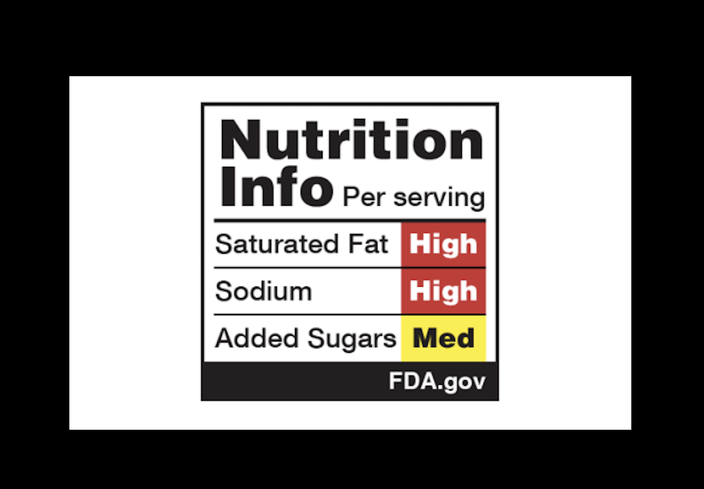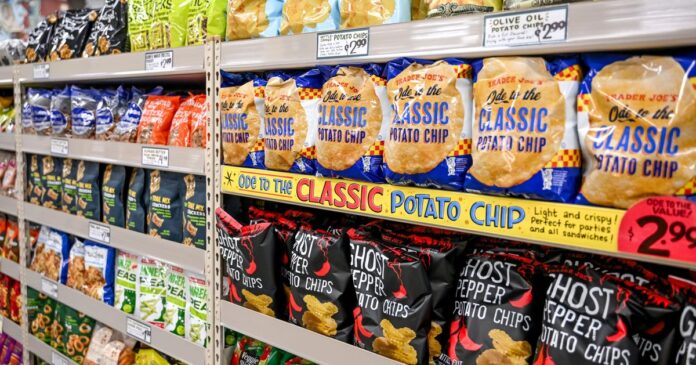Food and drink products like potato chips, cereals and sodas may soon get front-of-package labels that warn of high levels of added sugars, salt or saturated fats.
The Food and Drug Administration has been considering potential label options since 2022 and plans to make a formal proposal in October. The FDA has yet to send a draft proposal to the White House budget office, a requirement for public release, the Washington Post reported Friday. But a White House spokesperson told the newspaper that front-of-package labels are “one of the many key deliverables” in President Joe Biden’s public health strategy.
The change is aimed at reducing the prevalence of preventable health conditions like diabetes, heart disease and obesity. A new report released Thursday by the Centers for Disease Control and Prevention shows obesity rates among adults are higher than 40% in some states.

 Source/Reagan-Udall Foundation
Source/Reagan-Udall Foundation
This food label option, which attaches color codes to the content level of added sugars, sodium and saturated fats, is among those the FDA has considered requiring on the fronts of food packages.
The FDA has considered several front-of-package labels, including one that would note whether added sugars, sodium and saturated fats are “high,” medium” or low” using red, yellow and green color codes. For instance, products with added sugars that equal 20% or more of the daily amount per serving would be marked in red. Those with sugars that equal 5% to 20% would be marked in yellow, and those under 5% would be marked in green.
Another label option would simply note when a product contains high levels of one of those ingredients, without the color codes.
Early research has shown that black, stop-sign-shaped food labels – used by countries like Chile and Mexico – can change consumer shopping habits, the Wall Street Journal reported earlier this year. One large study found that people in Chile bought fewer products that carried the warnings. Food labeling researchers said those labels were easier to understand than standard nutrition labels currently on food packages in the U.S.
“People are busy. You might have a toddler screaming at you. It’s really hard to interpret and make sense of all that information on the back of the pack,” Lindsey Smith Taillie, a leading researcher on food labeling and associate professor at the University of North Carolina’s School of Public Health, told the Wall Street Journal in April.
The food and beverage industries have pushed back on the FDA’s push for front-of-package labels, with the Consumer Brands Association noting that obesity rates in Chile have gone up since country implemented them eight years ago.
Obesity remains a major health issue in the United States. The new CDC report shows there are now 23 states with obesity rates above 35%, up from 19 in 2021. Back in 2013, no state had an obesity rate above 35%. Nationwide, the obesity rate was 33.6% in 2022, down slightly from 33.9% in 2021.
New Jersey’s obesity rate was 28.9% in 2023, down slightly from 29.1 in 2022. Pennsylvania did not provide enough data to be included in the CDC’s most recent report, but it had a 33.4% obesity rate in 2022.
Though diet plays an important role in obesity rates, the CDC noted that the U.S. obesity rate is complex issue affected by many factors.
“There’s a common misconception that obesity is a result of lack of willpower and individual failings to eat well and exercise,” Ruth Petersen, director of CDC’s Division of Nutrition, Physical Activity, and Obesity, said in a statement. “Many factors contribute to obesity like genes, certain medications, poor sleep, gut microbiome, stress, access to affordable food, safe places to be active, and access to health care. Understanding these factors helps us identify potential prevention and treatment strategies.”
Biden’s office is moving forward with the FDA’s front-of-package proposal, but former President Donald Trump could kill the effort if he wins the presidential election in November. During his presidency, the U.S. pushed back on such labels during negotiations for the North American Free Trade Agreement, the Post reported.
Philadelphia has taken steps to inform consumers about the sodium content in the foods they purchase at some restaurants. Since 2019, the city has required chain restaurants to place sodium warnings on their menus next to foods that contain at least 2,300 milligrams of sodium, the maximum daily intake recommendation.



